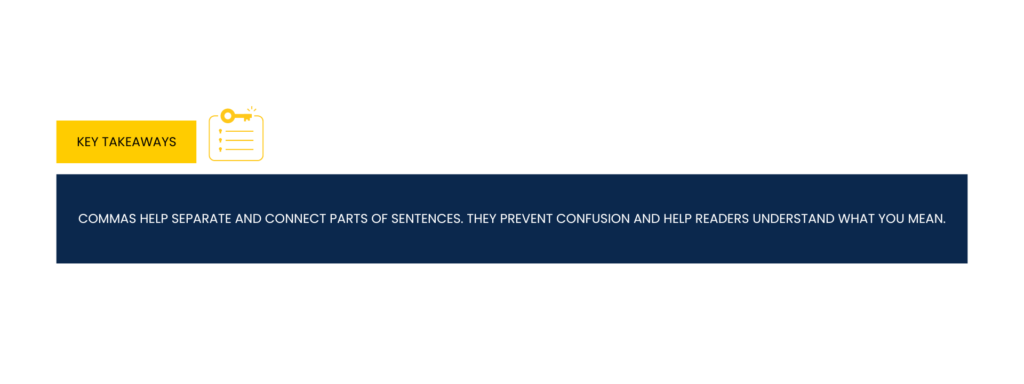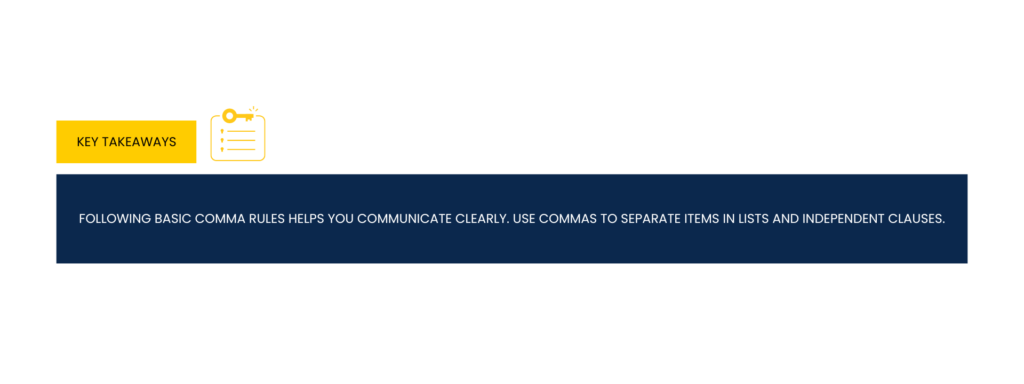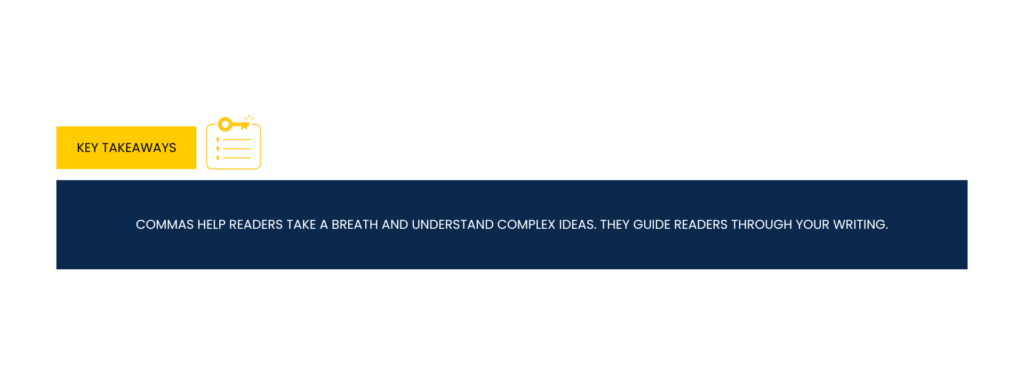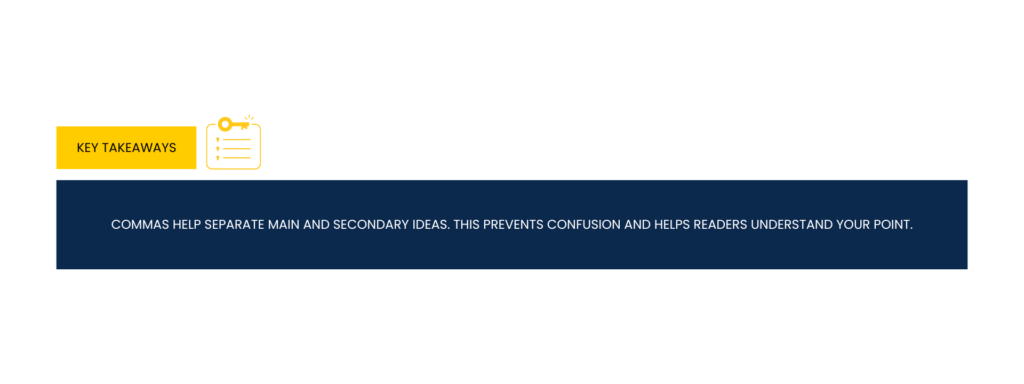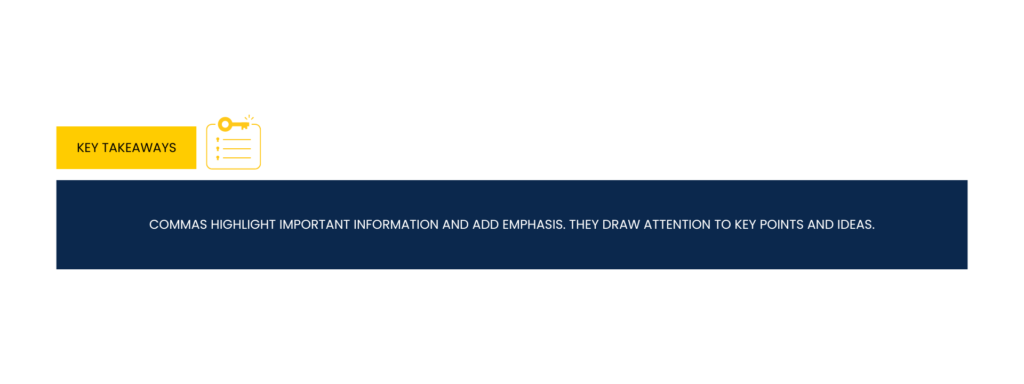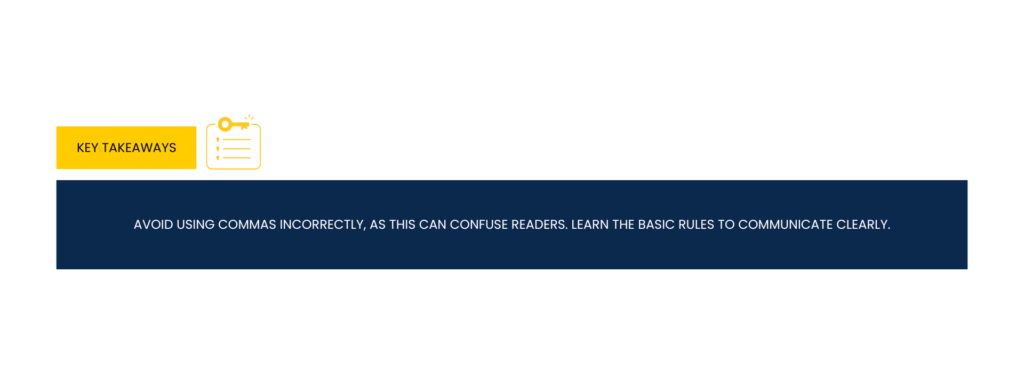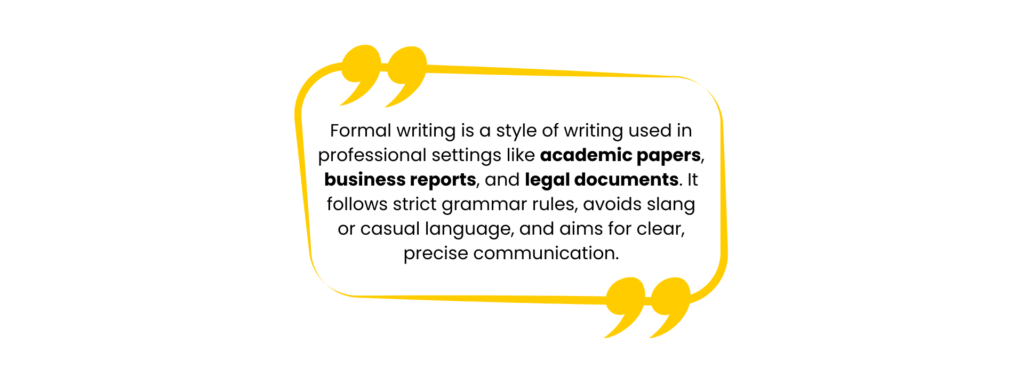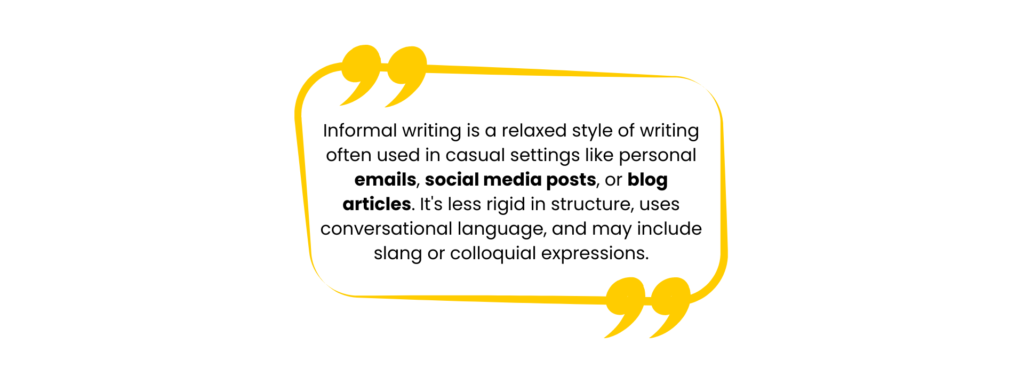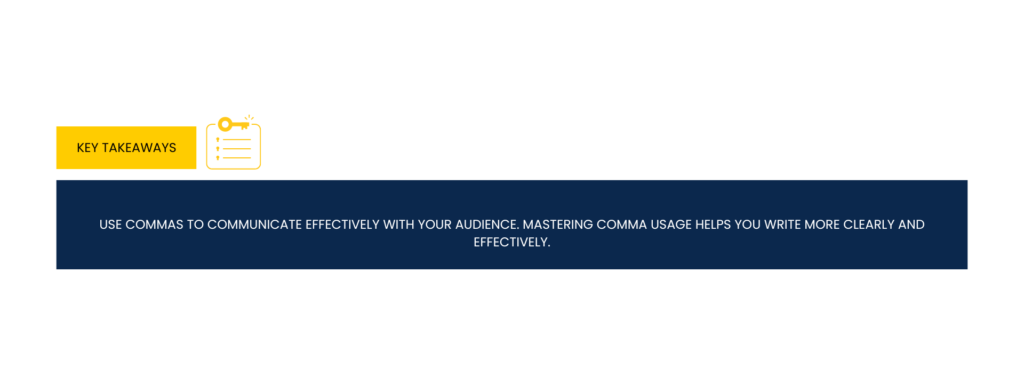
Even though it’s small, the simple comma is an important part of the English language. It makes sure that our writing is precise, clear, and strong. Its clearly small presence changes the meaning and flow of any text in a big way. Commas are very important to know for people who are interested in grammar, language teachers, and experienced writers. This guide goes into great detail about the complex role that commas play in sentences. It shows how to avoid common mistakes and how their use changes depending on the style of writing.
Table of Contents
ToggleThe Role of Commas in Sentences
Understanding the purpose: A comma is used for several things at its basis. It can show a short break in a sentence, divide ideas, or make the meaning of a phrase clearer. A comma is one of the most basic tools you can use to split things in a list. This type of comma, which is sometimes called the “Oxford comma,” comes before the last “and” or “or” in a list. For instance, “I like to write, read, and paint” has a series of commas before “and,” but “I like to run, hike, and swim” does not. When you use a serial comma, it can make things clearer, especially in law or formal papers.
Essential Comma Rules
Besides the series comma, it do many other things, such as separating sentences that aren’t necessary, beginning opening lines, and setting the context for tag questions. These words are very important for separating independent sentences when they come before conjunctions like “and,” “but,” or “so.”
Here are some cases that show how these rules work:
- “Living in the city, she rarely saw stars in the night sky.”
- “After the long winter, the flowers finally bloomed.”
- “You’re coming to the movie, aren’t you?”
Impact on Clarity and Meaning
Commas are crucial for making sentences clear and conveying the intended meaning. They can be used to separate important clauses or phrases, clarify a list of items, or indicate a pause in speech. Without commas, sentences can become confusing, and their meaning may be misinterpreted.
For example:
- “Let’s eat grandma!” (without comma) vs. “Let’s eat, grandma!” (with comma) The placement of a single comma can drastically change the meaning of a sentence and even have humorous consequences. Therefore, it is important to understand and use it correctly in order to effectively convey your thoughts and ideas.
Indicating Pauses and Phrasing
In written language, commas not only make sentence structure clearer but also mark natural breaks and direct the flow of phrases, similar to how musical writing sets the beat of a song. This is especially important when a person has a lot of thoughts or acts that need to be communicated. By knowing how to use it to indicate breaks, writers can make their writing flow more naturally and be easier to understand.
Here’s an example: “My cat, who usually ignores me, chose to sit on my lap while I read.” Here, commas do more than separate subjects and acts; they also add breaks that match the flow of speech, which helps the reader understand and be interested.
Differentiating between Clauses
In a sentence, commas are also needed to show the difference between dependent and independent sentences. Being made up of a subject, a verb, and a full thought, an independent phrase can be used as a sentence on its own. It may have a subject and a verb, but a dependent clause doesn’t say anything completely and can’t stand on its own. It’s easier for the viewer to understand how the sentence is put together and how the ideas are related when there are commas between them.
There is a comma between the dependent clause at the beginning of the line “If you finish your homework, you can watch TV” and the independent clause that comes after it. The clear meaning of the line is made clear by separating the condition and the result. Commas make it easier to see how two sentences relate to each other. If they are not used correctly, they could be confusing.
Emphasizing Elements in a Sentence
Commas don’t just divide words; they also draw attention to certain parts of a text by emphasizing them. This is very helpful when adding extra details about a word with an appositive term.
In the sentence “Maggie, my oldest friend, will join us tonight,” the commas around “my oldest friend” make Maggie stand out and emphasize the connection. By using commas in the right way, writers can give their lines more meaning and help readers understand better.
Fixing Misunderstanding
Commas are very important for making sure that words are clear. They split words or sentences so that readers can understand what the author meant. Lack of clarity can make people confused, which takes away from the point.
In the sentence “The painter, famous for his landscapes, decided to explore portraits,” leaving out the commas could make it sound like his fame for landscapes comes from his interest in portraits, which is not true. Using commas makes it clear that he was famous for landscapes before he started painting faces.
Using commas correctly in this way is important for formal papers, schoolwork, and everyday speech, showing how important they are for clear writing.
Common Mistakes to Avoid
Although commas have many important functions in writing, they are also a common source of confusion and errors. Here are some mistakes to avoid when using commas:
When use of Commas and Long Sentences
“Comma splice” is one of the most common mistakes people make when using commas. This happens when a comma connects two separate sentences without a connecting word, making a run-on sentence.
You should be able to spot these splices, like in “The sun is shining; we should go for a walk.” Adding a conjunction (‘and,’ ‘but,’ or “so’) after the comma or using a semicolon to join the sentences correctly will fix this.
Learn more about Comma Splice.
Overuse or Underuse of Commas
Putting too many commas in your writing can make it look divided as well as confusing, which can make it hard for people to follow your path of thought. On the other hand, not using enough commas can make blocks of text hard to read and understand. Finding the right mix is important, but there isn’t a single rule for how to use commas; it depends on the situation and what the writer wants to say. Getting to know the most common comma rules can help you figure out where to put them most effectively.
However, it’s also important to go with your gut and keep practicing using it to get better at it. By doing this, you’ll get a better sense of when and how to use it to make your writing clearer, more rhythmic, and easier to read.
Understanding Comma Usage in Different Writing Contexts
There are different ways to use commas in different writing styles and situations. For instance, when writing for school or work, you need to follow language rules more closely, like using commas. When writing creatively, on the other hand, you may have more freedom with how you use commas to make your own punctuation styles.
Formal Writing:
Effective use of commas is necessary for maintaining clarity and accuracy in official writing, such as academic papers, business reports, and technical documents. There needs to be a clearer and shorter style of writing for this, and commas are very important for making it easier to read and understand. Their careful use separates sentences, prevents misunderstandings, and makes lists clear, presenting information in a way that is organized and easy to find. These exact locations and use of commas are necessary for clearly communicating complicated information, which is why they are an important part of professional writing.
Examples:
- Academic Paper: “The study found that commas are essential in formal writing, as they clarify complex sentences and improve readability.”
- Business Report: “The company’s sales increased by 20% in the first quarter, thanks to effective marketing strategies and efficient use of commas.”
Informal Writing:
When writing in an informal style, like in social media posts, blog posts, and creative works, you can use commas in more ways to make it sound more like casual writing and more like how people talk.
In this type of writing, commas can be used in a lot more ways. They can be used to separate clauses and phrases, but they can also be used to punctuate and separate different thoughts or pauses in a story, similar to how we might pause to emphasize something or make something clear when we speak. This method helps to connect written and spoken language, which makes the text more interesting and understandable for the reader.
Examples:
- Social media post: “I love reading books, trying new recipes, and traveling to new places!”
- Blog article: “The best way to improve your writing skills is to practice regularly, read widely, and learn from others.”
Writing Styles
| Formal Writing | Informal Writing |
|---|---|
| Uses commas to separate independent clauses (e.g., "I went to the store, and I bought milk.") | May omit commas between independent clauses (e.g., "I went to the store and bought milk.") |
| Uses commas to list three or more items (e.g., "I like reading books, writing stories, and learning new things.") | May omit commas between items in a list (e.g., "I like reading books writing stories learning new things.") |
| Uses commas to set off nonessential clauses (e.g., "The report, which was written by a team of experts, was published last week.") | May omit commas around nonessential clauses (e.g., "The report was written by a team of experts and published last week.") |
| Uses commas to indicate pauses in speech (e.g., "The CEO, spoke clearly, and confidently, and inspired us all.") | Often uses commas to indicate pauses in speech (e.g., "The CEO spoke clearly, and confidently, and inspired us all.") |
| Always uses commas to separate dates and locations (e.g., "The meeting will be held on Monday, February 12, 2024, at 2 PM in New York, NY.") | May omit commas between dates and locations (e.g., "The meeting will be held on Monday February 12 2024 at 2 PM in New York NY.") |
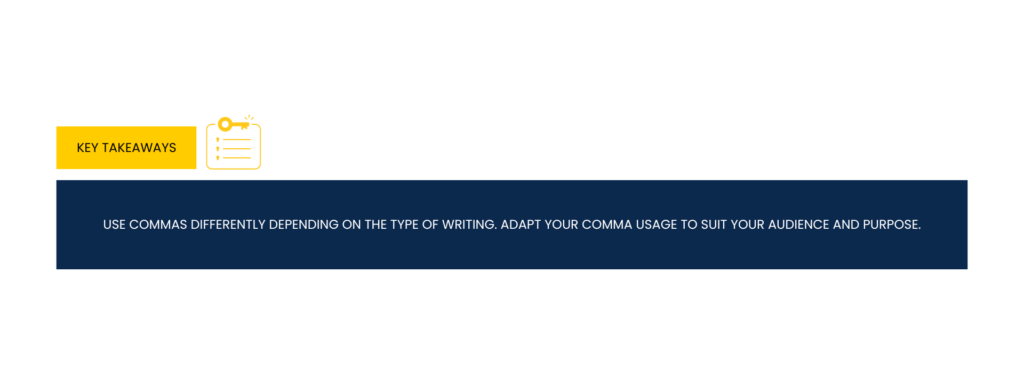
Adapting Comma Usage for Effective Communication
It’s important to know your audience and use commas correctly if you want to speak clearly. It is very important to fully understand how to use commas differently in official and conversational writing. When writing something serious, you should follow all the rules of grammar very carefully, which usually means using it more correctly. When writing informally, on the other hand, you can be more creative with punctuation, which could mean that you use commas less often.
You can improve the clarity and effect of your communication by being aware of these subtleties and changing how you write based on the situation and the people you are writing for. This method ensures that your message is not only received but also understood the way you meant it to be understood.
Conclusion
Commas are an important part of good writing, and using them correctly can make a big difference in tone, meaning, and clarity. To make their writing move better and make more sense, writers should know how to use it in different ways, such as to separate sentences, list items, and phrases, and show stops and punctuation. For successful communication, it is also important to know how to use it in different types of writing, like professional and casual writing. Writing is generally better when writers learn how to use it correctly. They can make their ideas clearer, keep readers interested, and get more responses.
Frequently Asked Questions (FAQ)
Q: What do commas do for you when you write?
A: Commas divide sentences and list items and phrases. They are also used to show breaks in writing and different ways of wording.
Q: How are a comma and a serial comma different?
A: Yes, a comma separates items in a list, and a serial comma, also called the Oxford comma, goes before the last item in a list to make things clear.
Q: What is a comma splice, and how do I avoid making one?
A: There is a comma splice when two separate clauses are joined together with a comma but no conjunction. To avoid this, divide the sentences with a space, a conjunction, or a semicolon.


